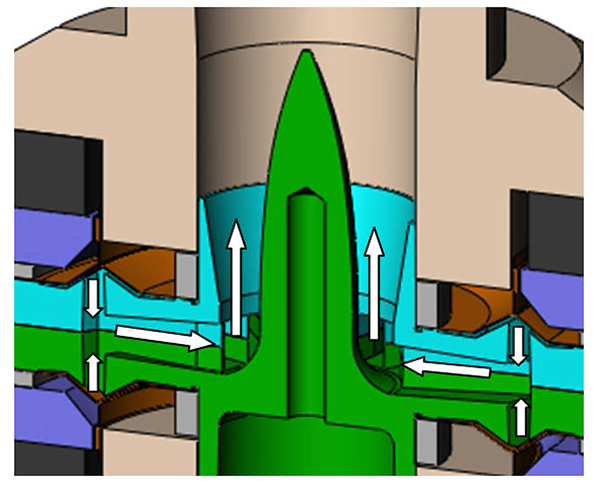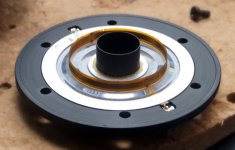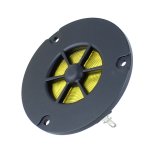FaitalPRO | HF Drivers | HF1440
-generally I'm not fond of ring-types at freq.s nearing their resonance. I find they are often lacking in the depth perspective.
Still, other than the pain-in-the-@ss Impedance - it's a nice looking driver, with excellent high-freq. extension for a 1.4" exit driver. Flux density is particularly high: should be very detailed (subjectively) as a result.
Might make for an excellent 1st order driver after correction (near 1.8-2 kHz). 😉 Of course this would require a horn loaded midrange, and both horns would need to be angled for a good integration window (vertically).
-generally I'm not fond of ring-types at freq.s nearing their resonance. I find they are often lacking in the depth perspective.
Still, other than the pain-in-the-@ss Impedance - it's a nice looking driver, with excellent high-freq. extension for a 1.4" exit driver. Flux density is particularly high: should be very detailed (subjectively) as a result.
Might make for an excellent 1st order driver after correction (near 1.8-2 kHz). 😉 Of course this would require a horn loaded midrange, and both horns would need to be angled for a good integration window (vertically).
The press release claims a lot of time was spent refining low frequency behavior. Wonder how it compares to other large format drivers down low. The high frequency is very smooth compared to most.
I was looking at 4" diaphragm compression drivers for a project but then this showed up last week for PL+S. Looks like many are going to ring-radiators for their flagship products.
Although comments on a comparison between the 950PB-Be and Axi2050 makes me pause for a bit. The person claimed that the 950 had noticeably higher resolution despite being matched very closely in frequency response and level.
On another forum someone has a JBL 2452H-SL ranked slightly ahead of the D2 for their preferences.
Maybe it has something to do with a large piston moving very little vs. small section of a ring trying to make the same spl....I don't know.
Guess I need to try both.
I was looking at 4" diaphragm compression drivers for a project but then this showed up last week for PL+S. Looks like many are going to ring-radiators for their flagship products.
Although comments on a comparison between the 950PB-Be and Axi2050 makes me pause for a bit. The person claimed that the 950 had noticeably higher resolution despite being matched very closely in frequency response and level.
On another forum someone has a JBL 2452H-SL ranked slightly ahead of the D2 for their preferences.
Maybe it has something to do with a large piston moving very little vs. small section of a ring trying to make the same spl....I don't know.
Guess I need to try both.
It looks quite promising. Wonder how much it will cost and when it will be available.
Regards
Charles
Regards
Charles
The press release claims a lot of time was spent refining low frequency behavior. Wonder how it compares to other large format drivers down low. The high frequency is very smooth compared to most.
I was looking at 4" diaphragm compression drivers for a project but then this showed up last week for PL+S. Looks like many are going to ring-radiators for their flagship products.
Although comments on a comparison between the 950PB-Be and Axi2050 makes me pause for a bit. The person claimed that the 950 had noticeably higher resolution despite being matched very closely in frequency response and level.
On another forum someone has a JBL 2452H-SL ranked slightly ahead of the D2 for their preferences.
Maybe it has something to do with a large piston moving very little vs. small section of a ring trying to make the same spl....I don't know.
Guess I need to try both.
Tend to agree here, In my VERY limited sample and experience, I favoured dome over ring radiator every time Ive used my ears.
(and both had DSP applied on same horn profile)
Just press-released, so it could be a month or so before it's offered from retailers.
My guess is that it will be somewhere between the 144 and 140 in price, or about $260-335 with maybe an initial price-bump from that range for "early-release".
My guess is that it will be somewhere between the 144 and 140 in price, or about $260-335 with maybe an initial price-bump from that range for "early-release".
Tend to agree here, In my VERY limited sample and experience, I favoured dome over ring radiator every time Ive used my ears.
(and both had DSP applied on same horn profile)
Interesting. Thanks for sharing.
I expect the HF1440 to be between $500-700 based on what the HF1400/2000 costs. Hopefully not.
Last edited:
Maybe it has something to do with a large piston moving very little vs. small section of a ring trying to make the same spl....I don't know.
Actually the ring-type in this instance is usually larger than typical compression driver: extending well beyond the diameter of the VC (..see BMS photo). At the same time though, the surface area is reduced at the center of the driver relative to a typical compression driver.
This makes it rather like a radial planar (see 2nd pic.), particularly with respect to how it's "clamped" at the edges of the diaphragm, and the resulting distortion profile that's generated from that sort of design (..typically with higher even-order artifacts in general - especially as you move toward resonance.)
(..of course the VC is radically different between the two, the planar's VC is etched to the surface of the diaphragm.)
The biggest (excursion) limit to a standard compression driver is the phase-plug - hitting it: as it's usually designed to be very close to the diaphragm. Ring-types though are limited by the diaphragm itself, and often the phase-path isn't at all a limit.
Integration in the design will be critical to get the best "HiFi" from it. It has that lower freq. extension - which is very useful,
-BUT
using that lower freq. extension very near the average (even though horn-loaded), could well end-up with a sound that is a bit "flat".
Again, to me this is not a driver I'd push lower in freq. for a crossover.. BUT it is one that suggests a low-order high-pass filter while having an extended upper freq. response. This makes it reasonably unique. If I were doing something more traditional (often with a super-tweeter to cover the top-octave), I'd look to the 18 Sound ND 1460A or ND 1480A ..
It's also interesting to note that BMS doesn't have anything quite like this design. All of their larger VC designs (that extend near 20 kHz w/ 3.5" VC) are coaxial units. This one from Faital Pro isn't.
Attachments
Last edited:
Interesting. Thanks for sharing.
I expect the HF1440 to be between $500-700 based on what the HF1400/2000 costs.
-if it's that (and your guess could well be correct), then they have priced themselves out of the market: with plenty of viable alternative-solutions.
This makes it rather like a radial planar (see 2nd pic.), particularly with respect to how it's "clamped" at the edges of the diaphragm, and the resulting distortion profile that's generated from that sort of design (..typically with higher even-order artifacts in general - especially as you move toward resonance.)
(..of course the VC is radically different between the two, the planar's VC is etched to the surface of the diaphragm.)
The biggest (excursion) limit to a standard compression driver is the phase-plug - hitting it: as it's usually designed to be very close to the diaphragm. Ring-types though are limited by the diaphragm itself, and often the phase-path isn't at all a limit.
These facts are what have me wondering. A ring radiator has the highest excursion at the voice coil with less towards the clamp (obviously). While a dome is moving the same distance along it's entire area until breakup occurs.
In the case of the Axi2050 vs. 950PB-Be, you have a 5" ring radiator with 1mm xmax against a 4" dome with maybe 0.25mm clearance. If I remember correctly, the entire ring isn't contributing to the high frequency output like a dome is.
I would imagine this would be detrimental to high frequency clarity at higher volumes compared to the large 4" be dome (when crossed in the dome's comfort range). The ring will have much more output down low but maybe at a cost to high frequency dynamics and detail.
How good are The Jubilees today? - Page 35 - Technical/Modifications - The Klipsch Audio Community
How good are The Jubilees today? - Page 35 - Technical/Modifications - The Klipsch Audio Community
This is splitting hairs for most people. Still, I find it interesting that there's not one design that totally out classes the other despite being newer and using the latest software available. Always a compromise.
Faital Followers.... are there any hints of Faital developing a coaxial compression driver using the HF1440 as the midrange, which could challenge the BMS 4594NE, B&C DCX 464? i.e. adding a high frequency coaxial ring radiator driver into the HF1440 chassis.
Not that I know of, though this one was only on my "radar" because of AudioXpress..
New FaitalPro HF1440 Compression Driver Extends Frequency Response and Power in a Compact Format | audioXpress
New FaitalPro HF1440 Compression Driver Extends Frequency Response and Power in a Compact Format | audioXpress
There was mention of one in developement a few years ago on this forum. I doubt it would be better than B&C.
In the case of the Axi2050 vs. 950PB-Be, you have a 5" ring radiator with 1mm xmax against a 4" dome with maybe 0.25mm clearance. If I remember correctly, the entire ring isn't contributing to the high frequency output like a dome is.
I would imagine this would be detrimental to high frequency clarity at higher volumes compared to the large 4" be dome (when crossed in the dome's comfort range). The ring will have much more output down low but maybe at a cost to high frequency dynamics and detail.
Should not the opposite be true, specially because of the special structure of the Axi's ring membrane? In any case, the whole dome is not contributing to the high frequency output either: such a big dome will stop being pistonic quite soon already, and then it's basically a big pile of resonances. The ring however has the advantage that the center to side length is always short, and then the Axi also has the special membrane shape that helps it control resonances much better. Both should help high frequency performance. I don't think even the Beryllium would help overcome the shortcomming of the big dome in the end.
Nevertheless, the devil is always in the details. There might be more to it than just these observations.
Maybe this has a phase plug that gives a planar wavefront?-generally I'm not fond of ring-types at freq.s nearing their resonance
What I'd like to know is does it perform well at 10kHz, and they say down to 700Hz so could it be used to 350Hz in a domestic situation.
A CD that covers all frequencies at and above the Schroeder Frequency would be very interesting.
Should not the opposite be true, specially because of the special structure of the Axi's ring membrane? In any case, the whole dome is not contributing to the high frequency output either: such a big dome will stop being pistonic quite soon already, and then it's basically a big pile of resonances. The ring however has the advantage that the center to side length is always short, and then the Axi also has the special membrane shape that helps it control resonances much better. Both should help high frequency performance. I don't think even the Beryllium would help overcome the shortcomming of the big dome in the end.
Nevertheless, the devil is always in the details. There might be more to it than just these observations.
The 4" Beryllium dome is pistonic out to 20khz. I'm not sure I would be able to hear a difference between them. $2,500 to find out doesn't sound too fun.
Maybe this has a phase plug that gives a planar wavefront?
What I'd like to know is does it perform well at 10kHz, and they say down to 700Hz so could it be used to 350Hz in a domestic situation.
..on-axis it looks good, and while it does have a phasing plug: my guess is that off -axis it's *not to good. 😱
The basic design doesn't look that different than the BMS 4594 midrange.
*of course this depends on the horn as well, for IF it's a particularly directive design at higher freq.s like perhaps a Le Cleach profile, then I doubt the result is bad.
FaitalPRO | HF Drivers | HF1440
-generally I'm not fond of ring-types at freq.s nearing their resonance. I find they are often lacking in the depth perspective.
Still, other than the pain-in-the-@ss Impedance - it's a nice looking driver, with excellent high-freq. extension for a 1.4" exit driver. Flux density is particularly high: should be very detailed (subjectively) as a result.
Might make for an excellent 1st order driver after correction (near 1.8-2 kHz). 😉 Of course this would require a horn loaded midrange, and both horns would need to be angled for a good integration window (vertically).
The ring radiators from BMS, Eminence and B&C have a reflector in their design:

This is a cutaway of the dual diaphragm D2430K from JBL, but the single-diaphragm models work the same way.
I'm really torn on this one, because the ring radiators measure really well, but I'm just naturally a bit wary of reflectors. And this is coming from someone who's basically spent the better part of the last decade building high frequency reflectors lol!
Square Pegs
Cloning a $3200 Speaker for $400
I have been able to make reflectors that actually outperform a design with a straight throat. But when you mess around with ABEC or Hornresp, you can see that a fraction of the energy is going to get reflected back down the throat.
Is it audible? Maybe.
Is it measurable? Probably, but it's extremely hard to quantify.
To me, it's hilarious that the ring radiator floodgates just opened up, now that the patent expired. Really demonstrates that a lot of manufacturers saw merit in the design, but were holding off on releasing them. Odd that Eminence jumped the gun (they released theirs over a year ago.)
The patent expired last month, IIRC.
The patent expired last month, IIRC.
- Home
- Loudspeakers
- Multi-Way
- HF1440 New Ring Compression Driver from Faital Pro.

